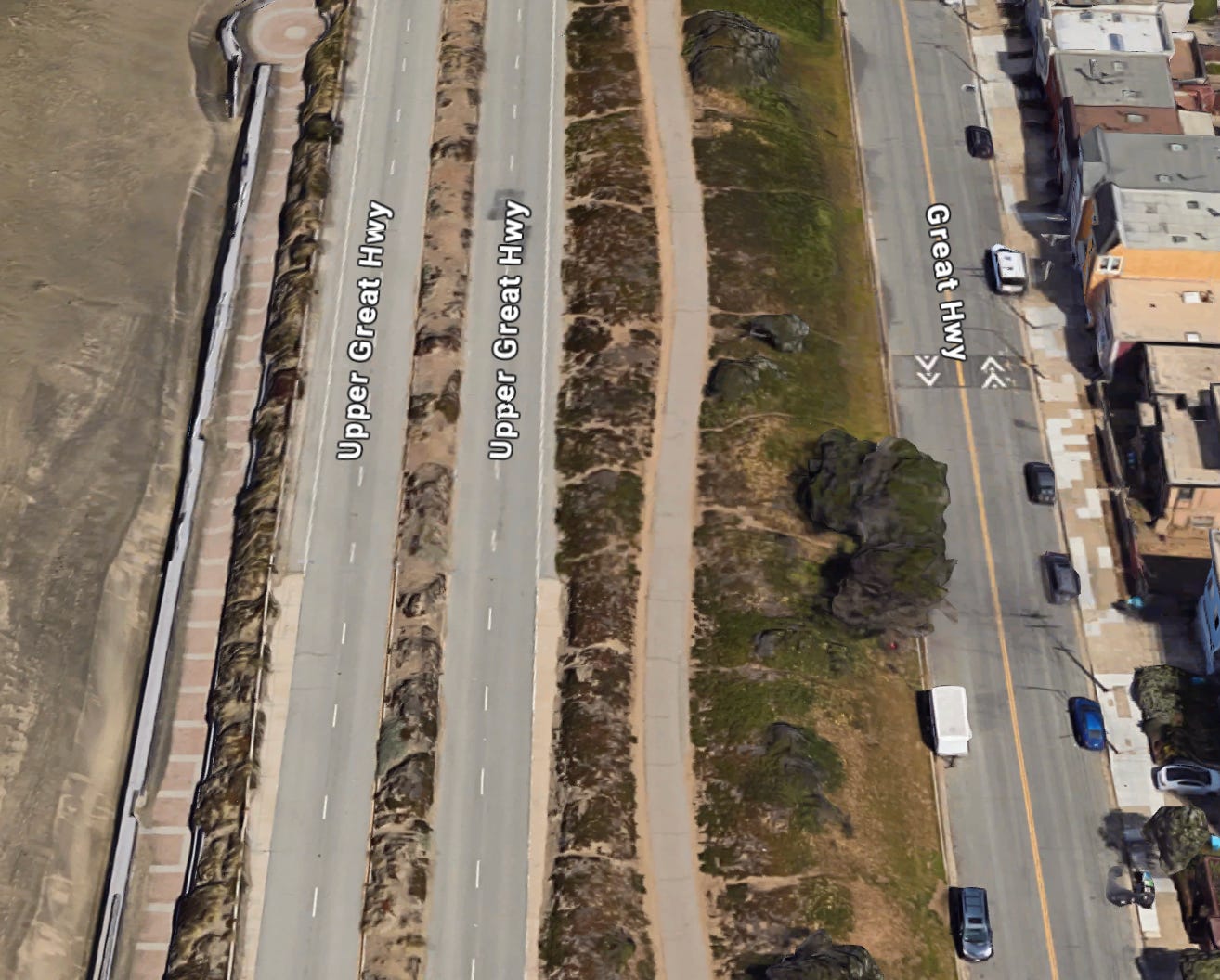Proposition K on November’s ballot asks San Francisco voters whether we want to permanently close the Upper Great Highway (UGH) to cars in favor of establishing what proponents optimistically refer to as an “oceanside park.” What comes to mind when I hear “oceanside park” is something like Santa Cruz Beach Boardwalk: an amusement park with rollercoasters, carnival games, funnel cakes, and an arcade. Who wouldn’t want that right in San Francisco? Unfortunately, what Prop K actually gives us is exactly what we have now, except that cars will be banned from driving on the road. That’s it. There is no plan or funding for doing anything to the road besides closing it to car traffic.
The section of the UGH which runs from Lincoln Way to Sloat Boulevard is currently closed to cars from noon on Fridays until 6 a.m. on Mondays. Traffic analysis showed that on weekends, about 8000 pedestrians and bikers use the road over 48 hours while car traffic over a 48 hour period was nearly twice that at about 14,500 cars. It is important to note that keeping the road open to cars does not prevent pedestrians or bikers from using it as well. What ever happened to “Share the road”?
The current setup from the ocean inland is a vast expanse of sand, a paved pedestrian path, UGH, a median about the same width roadway, covered in greenery with a narrow footpath, then “Great Highway” – a two lane local road with a sidewalk:
Proponents of Prop K repeat that their goal is “a permanent oceanfront park” – but we already have a permanent oceanfront park: Ocean Beach! It is immediately obvious to anyone who has visited that stretch of road that a vast expanse of beach is available and closing a few lanes of paved road doesn’t add anything in recreational value.
Does a pedestrian truly prefer walking on paved asphalt rather than the three sidewalks already available or sandy beach? Imagine a family with kids, beach blankets, umbrellas, coolers and sand toys making the journey to the oceanside park to spread out their chairs in the middle of a closed roadway. Why would anyone want to do that when the sand and sea are just yards away?
Other arguments in favor also don’t hold water.
Decreasing pollution? Closing a road doesn’t mean that those who use the road to commute suddenly cease to exist. Traffic studies have found that closing UGH increases commute times, increasing pollution. The car traffic, along with the pollution, simply gets pushed into residential neighborhoods. UGH has no cross traffic, meaning that its timed lights are perfect for moving cars efficiently and with minimal pollution.
Pedestrian safety? There are few reasons for pedestrians to cross UGH – closing it also diverts traffic into residential streets, increasing the likelihood of vehicle/pedestrian conflict.
Saving taxpayer money? The asphalt will remain and sand will still have to be cleared because the road will stay open to emergency and other authorized vehicles. This last point also contradicts the assertion that UGH is no longer useful as a road.
To understand the motivation underlying Prop K, look at its supporters. Supervisor Joel Engardio submitted the paperwork to get Prop K on the ballot at the last minute, possibly to prevent opponents from submitting an opposing proposition – a savvy political move. The San Francisco Bicycle Coalition would love nothing more than to ban cars from the city entirely. Liveable City, San Francisco YIMBY and GrowSF all support YIMBY policies like relaxing regulations and building more housing. This indicates that the push to ban cars could be motivated by real estate interest in developing the coastline. Property values would increase along this road if cars are permanently banned. The question boils down to “Should we inconvenience tens of thousands of San Francisco commuters every day so a few real estate developers can increase their profit?”
On a recent holiday, local political commentator Richie Greenberg filmed on the Upper Great Highway, showing nearly nobody on the closed road. The few pedestrians could easily have been accommodated by the existing paths. We do not have a problem of unmet pedestrian demand. Prop K proponents argue that UGH is often closed for because strong winds blow enough sand onto the road to block it. Now consider the famous fog and average temperature of 55 degrees – does that sound like a desirable setting for jogging, strolling, rolling and other recreation, especially when Golden Gate Park is right there?
A roadway closure that inconveniences tens of thousands of San Franciscan commuters daily should be well-motivated, but Prop K looks like a fantasy of turning San Francisco into Venice. The only people who could potentially benefit are bike bros and a handful of real estate developers.




Thanks for this. Today I drove the Great Highway from Sloat to Fulton, and I saw a lot of people enjoying themselves. There was a large sidewalk people were jogging on and walking their dogs, and there were bicyclists on the bike lane of GH. Everyone was positively sharing the space without any issues. It still saddens me that there are people who can't appreciate the fact that the current state of the GH accommodates everyone, and need to turn a highway for cars into walking space when they have an eight-foot wide sidewalk right next to it.
Ten words or less: It's simple. No Covid, no Great Highway closure.